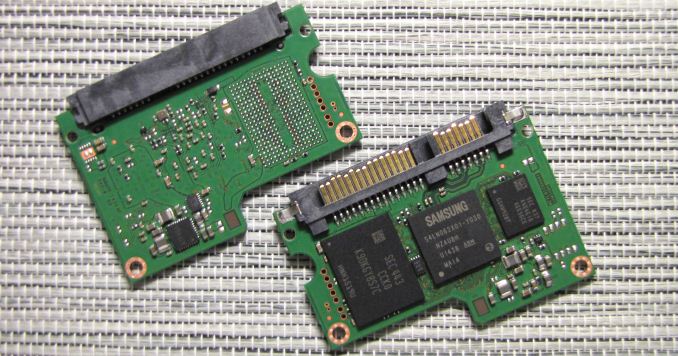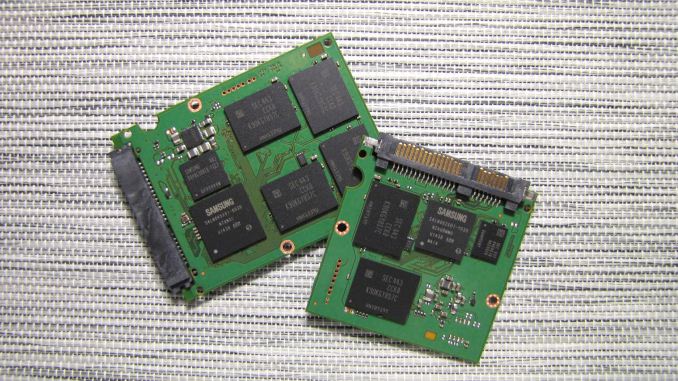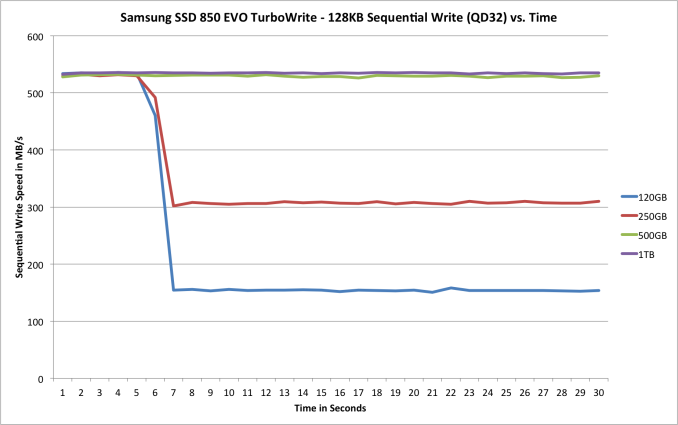Samsung SSD 850 EVO (120GB, 250GB, 500GB & 1TB) Review
by Kristian Vättö on December 8, 2014 10:00 AM ESTInside The Drives
There are three different PCB designs in the 850 EVO lineup. The 120GB and 250GB models (above) use a tiny PCB with room for two NAND packages (one on each side). Interestingly enough, both use octal-die packages, meaning that the 120GB 850 EVO only has a single 128GB (8*16GB) NAND package. Decoding the part number reveals that the packages are equipped with eight chip enablers (CEs), so a single NAND package is viable since all eight dies can be accessed simultaneously.
The use of octal-die packages is actually true for all capacities. It's an interesting choice nevertheless, but I suspect Samsung's packaging technology is advanced and mature enough that it's more cost efficient to use high die count packages and small PCBs instead of larger PCBs with more and less dense NAND packages.
| Samsung SSD 850 EVO NAND Configurations | ||||
| Capacity | 120GB | 250GB | 500GB | 1TB |
| # of NAND Packages | 1 | 2 | 4 | 8 |
| # of Die Per Package | 8 | 8 | 8 | 8 |
| Total # of Die | 8 | 16 | 32 | 64 |
| Die Capacity | 128Gbit | 128Gbit | 128Gbit | 128Gbit |
| Raw NAND Capacity | 128GiB | 256GiB | 512GiB | 1024GiB |
| Over-Provisioning | 12.7% | 9.1% | 9.1% | 9.1% |
TurboWrite
TurboWrite is a feature that Samsung brought to the 840 EVO to increase write performance. The idea of running a small portion of the NAND in SLC mode was nothing new, but it was the first time it truly made sense because the 840 EVO used slower TLC NAND and hence the SLC buffer could provide significant improvements to write performance and user experience. Unsurprisingly, TurboWrite is also present in the 850 EVO.
| Samsung SSD 850 EVO TurboWrite SLC Buffer Size | ||||
| Capacity | 120GB | 250GB | 500GB | 1TB |
| TurboWrite Buffer Size | 3GB | 3GB | 6GB | 12GB |
The buffer sizes and core architecture have remained unchanged. All writes hit the SLC buffer first, from which they then get moved to the TLC array during idle time. The only exception is a case of long, sustained period of writes that exceeds the buffer size, in which case the data will be written straight to the TLC portion.
| Write Performance With and Without TurboWrite | ||||
| With TurboWrite | Without TurboWrite | |||
| Sequential Write | 4KB Random Write (QD32) | Sequential Write | 4KB Random Write (QD32) | |
| 120GB | 520MB/s | 88K IOPS | 150MB/s | 38K IOPS |
| 250GB | 520MB/s | 88K IOPS | 300MB/s | 70K IOPS |
| 500GB | 520MB/s | 90K IOPS | 500MB/s | 80K IOPS |
| 1TB | 520MB/s | 90K IOPS | 520MB/s | 80K IOPS |
Samsung's reviewer's guide states that the 850 EVO features "enhanced TurboWrite technology" with a focus on random write performance, but I don't have any additional details as to how the TurboWrite implementation in the 850 EVO differs from the 840 EVO. TurboWrite was always designed to cache all writes regardless of the nature of the write (random vs sequential), so I'm not sure if anything has actually changed. Obviously the algorithms have been optimized for the new NAND and controller architecture and it's possible that the whole batch of algorithms has improved in the process, but I'll provide an update when I hear back from Samsung.
I ran a quick sequential write test to see how TurboWrite behaves in the 850 EVO. At smaller capacities it clearly provides a tremendous performance boost, but at 500GB and 1TB there is enough NAND to provide the parallelism that is needed to max out the SATA 6Gbps interface. That is a big improvement over the 840 EVO as its write performance maxed out at ~400MB/s when writing to the TLC array, so the performance benefits of 3D NAND technology are already evident.













97 Comments
View All Comments
TEAMSWITCHER - Monday, December 8, 2014 - link
I'm in complete agreement. I'm not going to buy another 2.5" SSD before I can get an 850 Pro (512 GB) equivalent with an M.2 interface. I have two motherboards with empty M.2 slots waiting for the market to catch up. I know about the XP941, but the pricing isn't great. M.2 drives should cost almost the same as a 2.5" drive...especially after eliminating the worthless metal/plastic box.extide - Monday, December 8, 2014 - link
Seems to me like TLC will become the standard mainstream for 3D/VNAND, where as MLC will be pretty much only for high end/enterprise, somewhat like SLC was back in the day.MadDuffy - Monday, December 8, 2014 - link
Newegg prices (USD) are up:120 GB - 90
250 GB - 140
500 GB - 250
1 TB - 470
Email I received indicates these are promotional prices available through Dec 14th
casperes1996 - Monday, December 8, 2014 - link
Last page, fifth paragraph, last line:"If I was"
Should be: "If I were"
I know I'm a cunt for pointing it out, but I only do so because I generally think Anandtech offers fairly decently written articles, and I care too much about this sort of piss...
Sorry.
apudapus - Monday, December 8, 2014 - link
How is data retention with this type of TLC NAND? Can the drive be powered off for a week or a month before data gets corrupted? While the drive is powered on, I assume there are refresh features for stale (a.k.a. infrequently accessed) data.hojnikb - Monday, December 8, 2014 - link
If its up to jedec (i imagine it is) then its good for atleast a year.kgh00007 - Monday, December 8, 2014 - link
But in reality what are they going to be like? I don't think I'll buy another Samsung TLC drive after owning the 120 GB 840 EVO for the last while! It performs erratically, especially when resuming from hibernate. It can take anywhere from 10 secs to boot, up to 5 minutes, and I have applied the latest firmware and run the speed recovery app from Samsung. I have an mSata Crucial m500 240GB which is slower on paper, but in reality is much quicker and the performance is 100% consistent, it does the same thing, every time at the same speed!!MLC all the way for me without any turbowrite nonsense, just straight forward advertised speeds across the whole drive all the time, without loosing data due to poor charge retention along the way!
Lolimaster - Monday, December 8, 2014 - link
Your EVO is 120 and your other drive is 240, less nand, more erratic, simple. Look at the chart, you get consistent writes/read with 500-1TB models.kgh00007 - Saturday, December 13, 2014 - link
Less nand equals slower performance, not more erratic performance. But it should perform at it's given speed consistentantly. I have over 30% of the drive free and 10% set as over provisioning on the 840 EVO. There is no excuse for a 5 minute boot time with an SSD. I don't trust these Samsung drives after my experience!mlkmade - Monday, December 8, 2014 - link
So I'm confused as its not very clear...Is Turbowrite turned on for all your benchmarks?Is turbowrite needed to hit the the 540/520 read/write times? I saw the chart with TurboWrite on and off. So with turbowrite off this drive only gets 100mb/s ?
This article is very vague in regards to that.